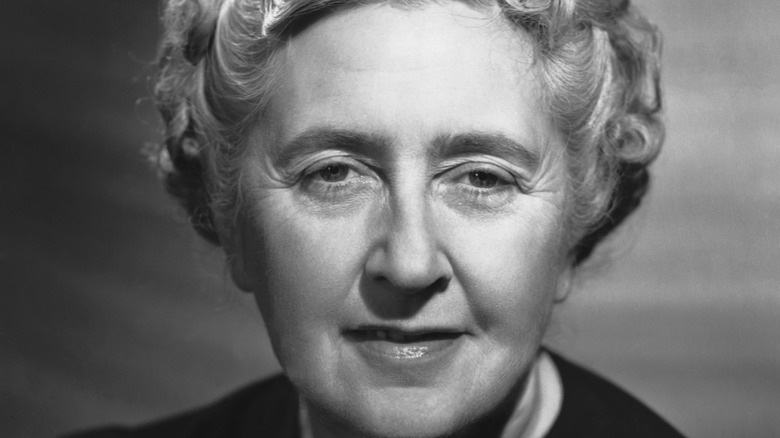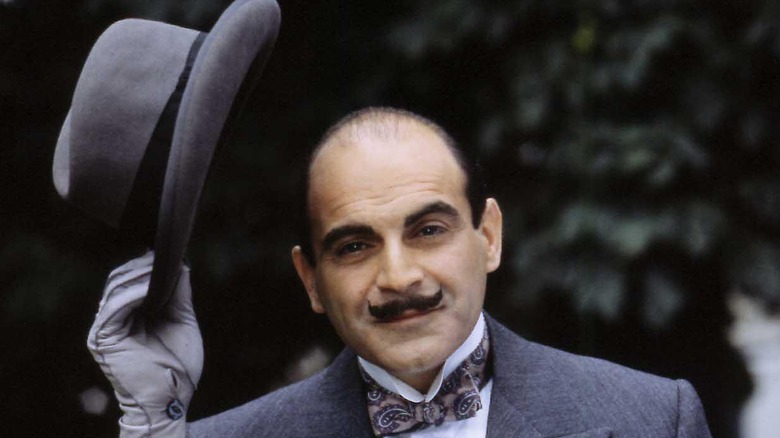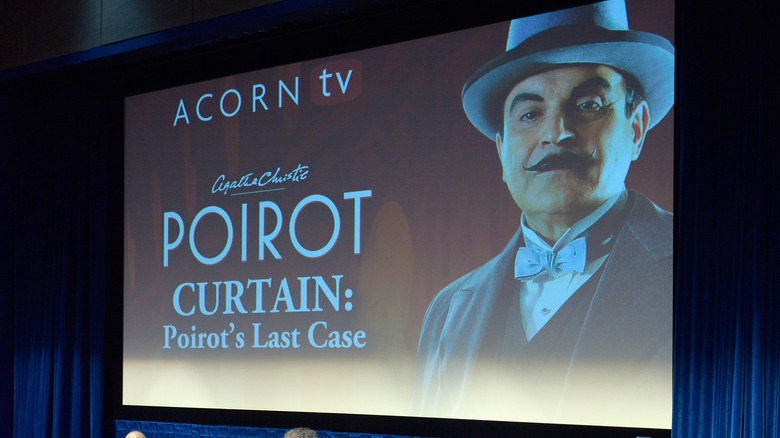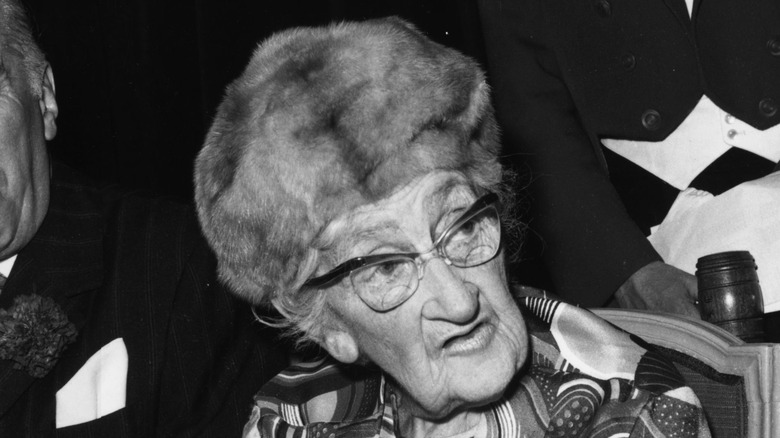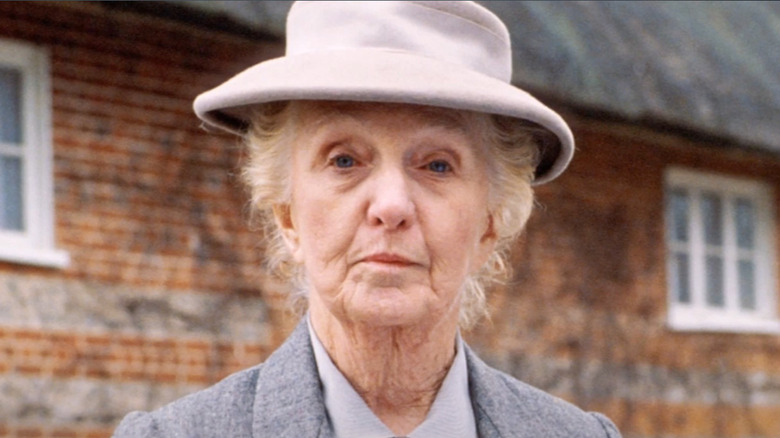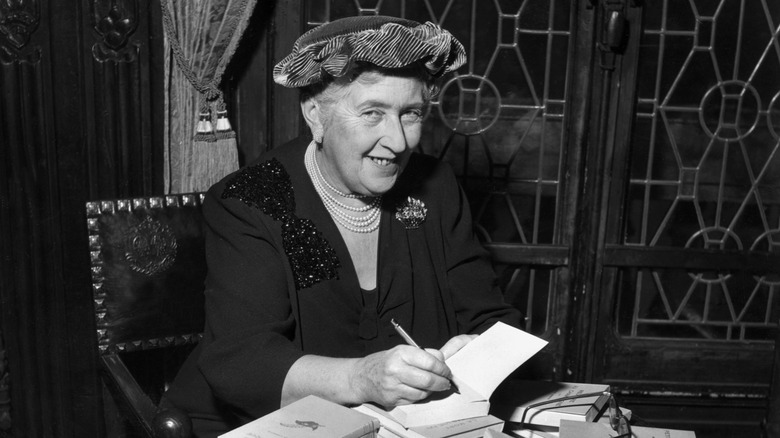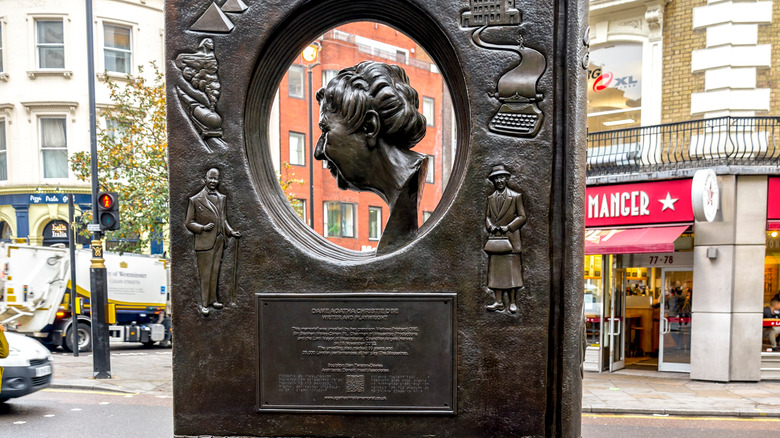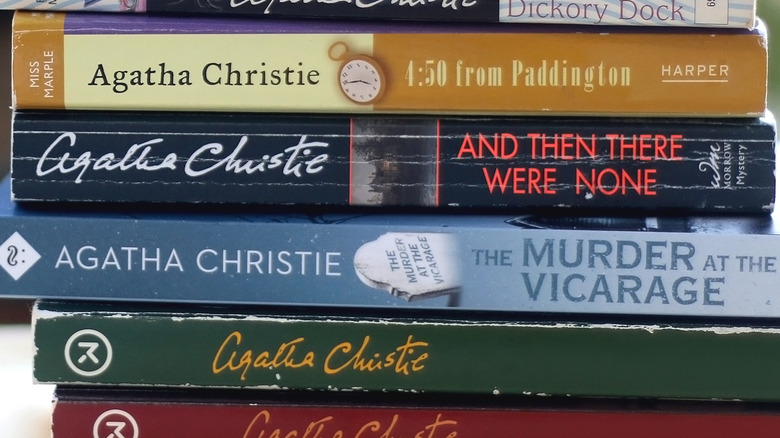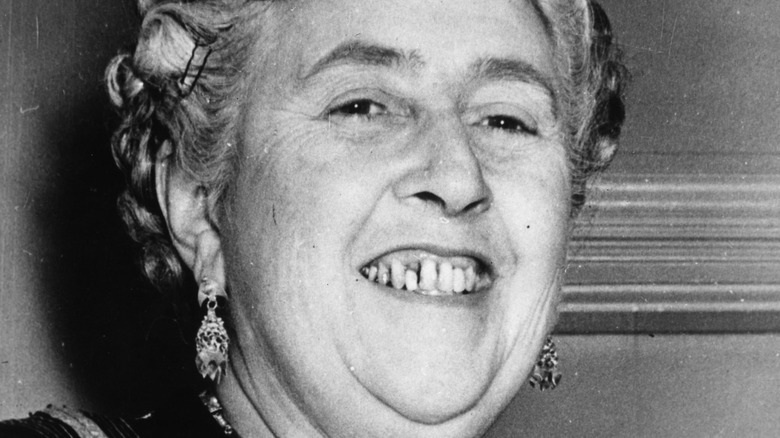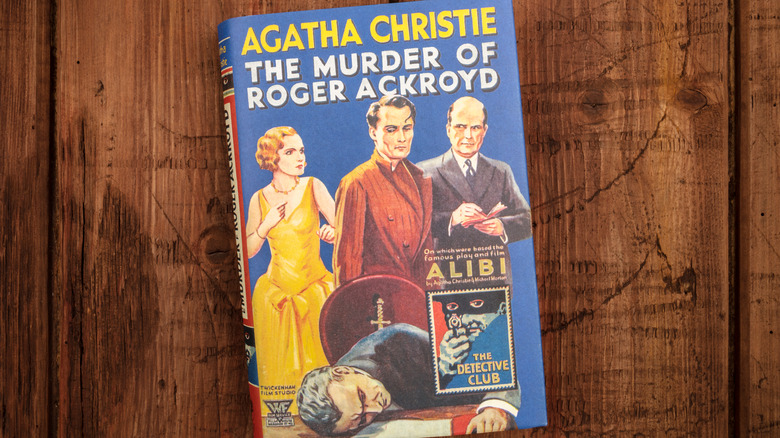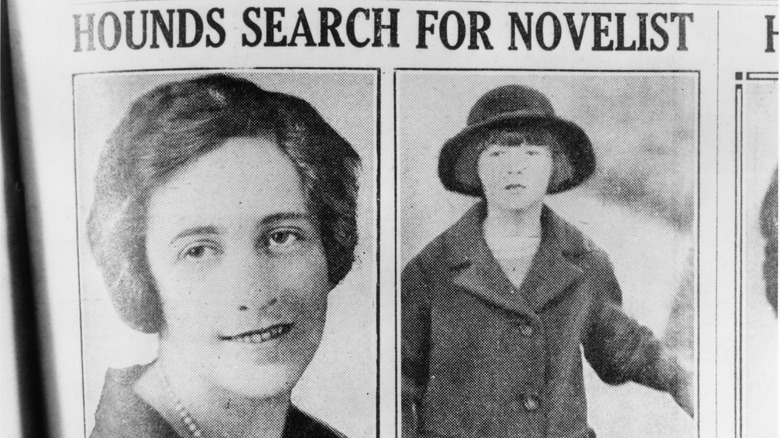The Best And Worst Agatha Christie Mysteries
Few authors have had the lasting cultural impact of Agatha Christie. Although Christie passed away in 1976 and published her last novel that same year, she remains one of the most popular authors in the world, with more than 1 billion books sold in more than 100 languages. Hollywood is still adapting her novels into blockbuster movies, and writers are still imitating her in terms of style and method. Even if you're not a book lover or not into mysteries, you've probably heard of her classic novels like "Murder on the Orient Express" or "Death on the Nile."
Christie wrote 75 novels, according to Britannica, 66 of which were detective stories. That's a lot of books, even for someone as obviously clever and talented as Christie, so it shouldn't be a surprise that some of those books are better than others — and some are actually not all that good. A mystery story is a delicate thing, after all — you have to construct not just a plausible murder, but also believable characters with acceptable motivations, twists and reveals that surprise without cheating, and a satisfying conclusion that shows the reader how you fooled them without making them feel foolish.
That's a high bar, and one the Christie cleared more often than not. But although most of Christie's works range from good to great, some stand out for good reasons or bad. Here are the best and worst Agatha Christie mysteries.
Best: Cards on the Table
Often overlooked — even by Christie fans — this 1936 novel is easily one of the best mysteries Christie ever constructed. In a story that Business Insider describes as a "suspenseful murder mystery full of plot twists," four detectives (including Hercule Poirot) with unique styles of investigation are invited to play bridge by the wealthy (and suspicious) Mr. Shaitana.
CrimeReads notes that Shaitana is one of the most memorable characters in any of Christie's books. A man who lacks any sort of moral compass, Shaitana is a sociopath, but a charming, urbane one who almost makes the concept of "collecting" murderers seem cool. When Shaitana is found dead after the game of cards breaks up — murdered literally in front of the whole party — it's up to the four detectives and the four "murderers" to figure out what happened.
As noted by Bookrags, "Cards on the Table" is considered one of the finest locked-room mysteries ever devised, in part because of the large cast of characters who should have witnessed the crime. While the mystery itself is very clever (and the solution very satisfying), what really makes this one of Christie's best are the characters. Bringing their own unique style, the characters leap off the page and bounce off of each other in entertaining, plausible ways. If you're only familiar with Christie's better-known works, check out this underrated classic.
Worst: Elephants Can Remember
It's almost unfair to nail 1972's "Elephants Can Remember" as one of her worst novels. Christie, already 82 when the book was published, may have been in the midst of a mental decline. According to The Guardian, many had long suspected Christie was dealing with Alzheimer's Disease in her later years, and a study conducted at the University of Toronto concluded that "Elephants Can Remember" showed evidence of a decline in vocabulary and an upsurge in repetition. Whatever the reason, there's little doubt that the novel represents a sudden and noticeable downturn in quality — NPR describes it as "full of errors and poorly plotted."
Those errors are maddening because, in many cases, they show up as details that change between chapters, something you might imagine any capable editor would have been able to address even if the author was no longer capable. As critic Robert Barnard notes in his book "A Talent to Deceive," the book is "another murder-in-the-past case, with nobody able to remember anything clearly, including, alas, the author."
Worse, much of the novel simply meanders. Gone are the tight plotting and skillful character work of Christie's best, the characters here simply talk in circles for pages at a time. The fact that the character of Ariadne Oliver — long suspected of being a stand-in for Christie herself — is suffering from memory loss herself adds an element of poignancy to the story but doesn't make it any better.
Best: Curtain: Poirot's Last Case
Hercule Poirot is one of Agatha Christie's most famous creations. The fictional Belgian detective with the ridiculous mustache has become embedded in popular culture, and, as noted by The New York Times, has been portrayed in films and television adaptations by some of the most famous actors in the world, including his current incarnation, Kenneth Branagh. According to The Radio Times, it's also well-known that Christie came to despise her own character — which makes the fact that one of her best books is Poirot's last case fascinating. It's easy to imagine Christie's enthusiasm for killing off the character inspired her.
"Curtain" is Hercule Poirot's final mystery, and was published in 1975 — but, as noted by The Guardian, was actually written in the 1940s during World War II, when Christie worried she might not survive. The manuscript was stored in a safe until she was ready, three decades later, to retire the character. The story is engrossingly dark, with a wheelchair-bound Poirot returning to the scene of his first adventure, ruminating on death and murder. The story culminates in a final reveal that remains shocking to this day. As noted by author Richard Hack in his book "Duchess of Death: The Unauthorized Biography of Agatha Christie," critic Matthew Coady said that Christie was "at the peak of her ingenuity" in "Curtain," and in his book "Poirot and Me," actor David Suchet notes that critic Maurice Richardson called the book "unputdownable."
Worst: Postern of Fate
Agatha Christie's characters of Tommy and Tuppence aren't nearly as famous as Hercule Poirot and Miss Marple. She only wrote five novels featuring the pair, with the final one ("Postern of Fate") coming in 1973, just a few years prior to her death. Unfortunately, the novel shows Christie's decline. Crime-solving spouses Tommy and Tuppence Beresford age over the course of their five novels, and they are retired and elderly in "Postern," reflecting Christie's age. They purchase a new home in which to spend their golden years, and discover a clue to a murder that may have taken place 60 years earlier. The premise offers Christie plenty of room to contemplate age, memory, and the past, which could have been a fascinating story.
The resulting story, however, is extremely confusing — in large part because of glaring errors Christie makes. As noted by author Bruce Pendergast in his book "Everyman's Guide to the Mysteries of Agatha Christie," the characters don't remember what they "said a mere four or five seconds before." The characters confuse names, places, and dates repeatedly. There are also what Pendergast describes as "time warps" in the book, as events and recollections in the story never quite add up.
The result is, simply put, a bad novel. "The Cambridge Guide to Women's Writing in English" puts it very succinctly, calling the book "execrable" and stating that it's an example of how Christie lost "her grip" towards the end of her life and writing career.
Best: Murder on the Orient Express
If you know nothing else about Agatha Christie and her work, you probably know about this classic novel. Considered one of the best mystery novels of all time, The Guardian describes it as "predicated on an inspired gimmick" and as having "one of the great surprise endings in the genre."
The story is efficient perfection: Hercule Poirot travels via the legendary Orient Express, and is approached by Mr. Rachett, a man with a sketchy reputation. Ratchett begs Poirot for his protection, but Poirot refuses — and the next day, as the train is stopped on the track by heavy snow, Ratchett is found dead, with an entire train car full of suspects. The result? A novel The Independent calls "a perfect twist on the locked room mystery."
The real test of a novel with a twist of the size and scale of this one is re-readability, and what is amazing about "Murder on the Orient Express" is that Christie's skill with detail, subtle clues, and character work makes this novel worth reading even after you know the secret. As noted by Kelli Stanley in the book "Books to Die For," "Murder on the Orient Express" is "far more than a logic problem," it's a story that delves into the definition of criminality and guilt while also exploring a world whose concept of evil was changing as it hurtled towards World War II. That surprising depth is why it's still considered a classic today.
Worst: Nemesis
A late-era novel that's easily the worst Miss Marple story Christie ever wrote, "Nemesis" combines a thin, uninteresting mystery with some shockingly bad writing. As noted by Make a Date of It, much of the story is given over to lengthy paragraph-long speeches by characters, who then respond in more paragraph-long speeches that more or less reiterate the same ideas and statements. It's repetitive and boring.
The mystery itself isn't much: An old acquaintance, Mr. Rafiel, passes away, and Miss Marple discovers a girl named Verity was once engaged to marry Mr. Rafiel's son — but the girl was murdered. As noted by author J.C. Bernthal in "The Bloomsbury Handbook to Agatha Christie," the story bears a resemblance to the plot of "Sleeping Murder," a novel Christie wrote in the 1940s but which remained unpublished at the time "Nemesis" came out, leading some to wonder if this was an attempt to re-use old plots.
Worse than bad writing and a dull mystery, it's one of the few of Christie's books that have aged really poorly. Characters discuss sexual assault as if it's a choice women make — or perhaps something women actually desire. And "Nemesis" treats homosexuality as a defect, hinting that a lesbian would be more inclined to murder and other bad behavior due to their orientation.
If you or anyone you know has been a victim of sexual assault, help is available. Visit the Rape, Abuse & Incest National Network website or contact RAINN's National Helpline at 1-800-656-HOPE (4673).
Best: The ABC Murders
Criminally underappreciated. "The ABC Murders" is one of Agatha Christie's best mysteries, long overshadowed by her more famous books. The New York Times says the book "showcases [Hercule Poirot] at his brainy best," and critic Dean Poling notes that the novel still "feels modern" and believes it's superior to more famous Christie books like "Murder on the Orient Express" and "Death on the Nile."
It's easy to see why: The Guardian calls the premise "beautifully simple." As Poirot tackles a case where people are being murdered in alphabetical order, Christie introduces a complex plot structure, a deep dive into criminal psychology, different narrative techniques (including, as noted by The Independent, the combination of third- and first-person narratives) — and one of the rare literary mysteries you can actually solve yourself on a first read with a little brain work.
The solution is brilliant — and yet totally believable — and story elements like the taunting letters Poirot receives and the way the murders keep happening as Poirot works feverishly to stop them do indeed make the story feel as modern as any murder mystery airing on Netflix today. In fact, Book Riot says that every novel about a detective struggling to connect a serial killer's victims "exists because this book did it first."
Worst: Passenger to Frankfurt
Agatha Christie was 80 years old when she published "Passenger to Frankfurt." Although it's not a mystery per se, it suffers from the twin sins of being incredibly dull and also incredibly confusing. As noted by BookScore, critic Robert Barnard wrote in his book "A Talent to Deceive" that the novel "slides from the unlikely to the inconceivable and finally lands up in incomprehensible muddle," adding that "prizes should be offered to readers who can explain the ending."
The story follows a British diplomat, Sir Stafford Nye, who meets a woman at the Frankfurt airport who begs him to help her because someone is trying to kill her. He reluctantly helps, then keeps meeting the same woman over and over again, always introduced under a new name. He's slowly involved in a dense game of politics with deadly stakes. It sounds interesting enough, and a slightly younger Christie no doubt could have handled it well. But as Make a Day of It notes, the book is just tremendously boring, and the conspiracy at the heart of it is, frankly, ridiculous and difficult to understand. Filled with endless characters who do nothing much, this book is tedious to a fault.
Worst of all, a lot of the speeches the characters make sound very much like an aging, affluent woman complaining about the state of the world. It's simply not entertaining.
Best: And Then There Were None
As noted by The Guardian, "And Then There Were None" is one of the most ripped-off novels in history. The central story of a dozen strangers — each hiding a secret — invited to a remote island where they are murdered one by one has been, er, borrowed by other writers ever since this novel's publication in 1939.
That's because the story is nearly perfect — in fact, The New York Times calls it "possibly the most perfectly crafted locked-room mystery of all time." There are no wasted words, no crazy coincidences, no cheats. Despite playing fair, the ending always surprises on an initial read — it's one of those perfect twists that makes sense after you learn it, and holds up even as you re-read the book.
The combination of isolation — the story takes place on a small island off the coast of Devon that can only be accessed by water — and the growing paranoia of the guests as they realize the killer must be one of the shrinking number of survivors makes this a tense, dread-filled experience. It's no surprise that How Stuff Works reports that "And Then There Were None" is one of the best-selling books of all time, with sales of more than 100 million copies — and counting.
Worst: By the Pricking of My Thumbs
The characters of Tommy and Tuppence are only really known to true Christie fans — casuals don't usually get past the most famous Hercule Poirot and Miss Marple mysteries. And they are, by and large, better off for it; Christie wrote five novels about Tommy and Tuppence, and two of them are among her worst efforts. "By the Pricking of My Thumbs" is one of those.
This is the fourth Tommy and Tuppence novel, and Christie wrote it 20 years after the third one, apparently in response to demands from fans to know what the detective couple was up to. As noted by critic Robert Barnard in his book "A Talent to Deceive," the story starts off strong. A middle-aged Tuppence has a strange conversation with an elderly woman, and this spurs her to follow breadcrumbs that eventually lead to a series of chilling murders. But Barnard also notes that the story "declines rapidly into a welter of half-realized plots." And author Earl F. Bargainnier notes in his book "The Gentle Art of Murder" that the book suffers egregiously from confusion and inconsistency, as details get mixed up. As a result, it's actually impossible to figure out the actual sequence of events in the plot. Add on the late-era Christie tendency to have her characters speechify for endless paragraphs, and you've got a dull, confusing book.
Best: The Murder of Roger Ackroyd
As noted by Book Riot, this is the novel that made Agatha Christie a legend — The Independent reports it was voted the best crime novel ever published by the Crime Writer's Association. The twist in this book is absolutely incredible and remains legendary to this day. Narrated by Dr. James Sheppard, who acts as a kind of local assistant when Hercule Poirot investigates the murder of the wealthy Roger Ackroyd, The Guardian notes that the deception is almost perfect: The story seems like a "typical village murder mystery" up until the explosive, incredible final chapter when the killer reveals themselves.
As noted by critic Robert Barnard in his book "A Talent to Deceive," the "unprecedented and unguessable" solution to the mystery in the book caused controversy, with many critics and readers feeling tricked. But as The Guardian reports, the fact is that Christie plays fair — the clues to the true solution to the crime are littered through the novel and jump out at the reader on a second trip through the story. Even more incredible is the fact that if you were to change that last chapter and come up with a more expected and "traditional" ending to the story, it would still be a fine mystery, well worth reading. The twist simply elevates it to legendary status.
Worst: The Big Four
Published in 1927, "The Big Four" is technically a Hercule Poirot mystery, but as pointed out by Book Riot, it's not really a mystery — it's a spy story. The plot, such as it is, involves Poirot and his usual sidekick Captain Hastings pursuing a quartet of Illuminati-types who plot and plan various deadly conspiracies, eventually introducing the potentially interesting existence of Poirot's identical twin brother, Achilles — only to turn that intriguing twist into a huge disappointment.
As noted by author Elizabeth Walter in the book "Agatha Christie," one reason the book doesn't work is that it's what folks in the publishing industry call a "fix-up" novel, meaning it started off as separate, independent short stories that were later combined into a novel. As a result, critic Robert Barnard calls the book "cobbled together" in his book "A Talent to Deceive," noting that the book was put together with the assistance of her brother-in-law, Campbell Christie, during the "lowest point in Christie's life" after her divorce and subsequent disappearance for more than a week, long suspected to be some sort of emotional breakdown.
While fixing up stories into novels can have terrific results, that wasn't the case here. The story's twist is pretty predictable, and the plot unfolds in a messy rush. The novel was an afterthought, and it reads like one.
